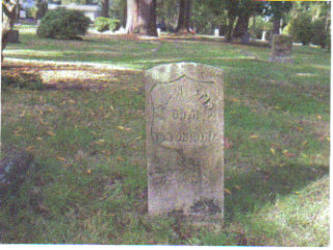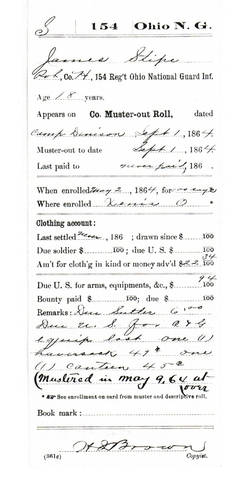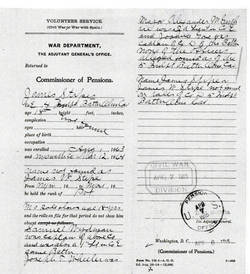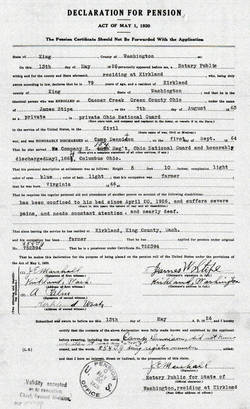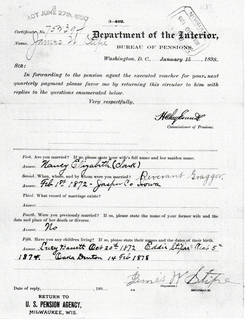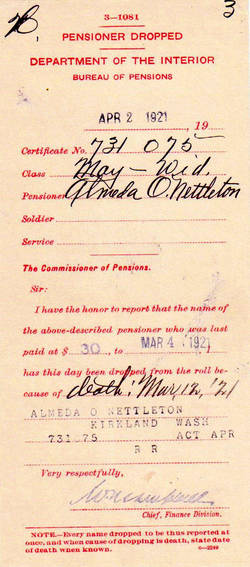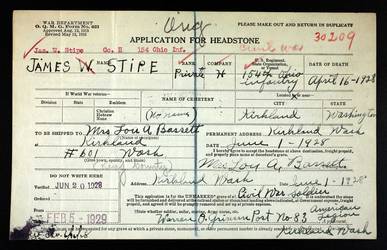James Stipe
Representing: Union
Unit History
- 4th Ohio Independent Battalion Cavalry E
- 154th Ohio National Guard Infantry H
Full Unit History
4th INDEPENDENT BATTALION OHIO VOLUNTEER CAVALRY
Organized: 8/3 to 9/21/63
Mustered In: By companies 8/3 - 9/21/63
Mustered Out: By companies 2/15 - 3/14/64
154th OHIO NATIONAL GUARD VOLUNTEER INFANTRY
Organized:Spring, 1864 Camp Dennison, Cleveland, OH
Mustered In: 5/9/64 Camp Dennison, Cleveland, OH
Mustered Out: 9/1/64 Camp Dennison, Cleveland, OH
Regimental History
REGIMENTAL HISTORY: (4th)
The 4th, a battalion, composed of five companies, was organized at Cincinnati, OH from 8/3 to 9/21/63. It was to serve for six months. Part of the unit was in service during Confed. John Hunt Morgan's raid into Ohio. Subsequently the unit was sent to eastern Kentucky where, although it participated in no regular battles, it performed good service in protecting citizens from raids by guerilla bands which, at the time, infested that region.
Battalion losses: Officers killed or mortally wounded: 0; Officers died of disease, accidents, etc.: 0; Enlisted men killed or mortally wounded: 0; Enlisted men died of disease, accidents, etc.: 16.
REGIMENTAL HISTORY: (154th)
During the spring of 1864 Union commander General U.S. Grant began pulling “experienced" troops from rear echelon positions in order to strengthen his field armies as they prepared to drive deep into The South in a campaign which, a year later, would bring an end to four years of bloody American Civil War. To fill the void created by these withdrawals many short term, primarily non-combat units were created. One such regiment was the "100 Day" 154th Ohio. It was composed of the 23rd Battalion Ohio National Guard from Madison County and the 60th Regiment Ohio National Guard from Greene County. Throughout its 100 days of existence the 154th was assigned to the Department of West Virginia.
On 5/12/64 the 154th proceeded via Columbus and Bellaire to New Creek, West Virginia, arriving there on the evening of the 14th. On the 22nd Company "F" was ordered to Piedmont where it remained until the regiment started for Ohio and final muster.
The regiment performed guard, picket and escort duty until 5/29 when one company was moved to Youghiogheny bridge and the remaining eight to Greenland Gap. On 6/4 a detachment of the unit had a skirmish with McNeill's battalion near Moorfield. From 6/12 to 7/4 detachments of the regiment were then sent on various scouting expeditions and on 7/25 the unit again fell back to New Creek. A Confederate attack on those New Creek forces occurred on 8/4 before, on 8/22, the 154th started back to Ohio for its 9/1 final muster.
Regimental losses: Officers killed or mortally wounded: 0; Officers died of disease, accidents, etc.: 0; Enlisted men killed or mortally wounded: 1; Enlisted men died of disease, accidents, etc.:3.
Soldier History
SOLDIER: (4th)
Residence: Paintersville Greene Co., OH Age: 16.6 yrs.
Enlisted/Enrolled: 8/1/63 Caesar’s Creek, OH Rank: Pvt.
Mustered In: 9/21/63
Mustered Out: 3/12/64
Highest Rank: Pvt.
SOLDIER: (154th)
Residence: Paintersville Greene Co., OH Age: 17.2 yrs.
Enlisted/Enrolled: 5/2/64 Rank: Pvt.
Mustered In: 5/9/64
Mustered Out: 9/1/64 Camp Dennison, Cincinnati, OH
Highest Rank:Pvt.
On 5/12/64 the 154th proceeded via Columbus and Bellaire to New Creek, West Virginia, arriving there on the evening of the 14th. On the 22nd Company "F" was ordered to Piedmont where it remained until the regiment started for Ohio and final muster.
The regiment performed guard, picket and escort duty until 5/29 when one company was moved to Youghiogheny bridge and the remaining eight to Greenland Gap. On 6/4 a detachment of the unit had a skirmish with McNeill's battalion near Moorfield. From 6/12 to 7/4 detachments of the regiment were then sent on various scouting expeditions and on 7/25 the unit again fell back to New Creek. A Confederate attack on those New Creek forces occurred on 8/4 before, on 8/22, the 154th started back to Ohio for its 9/1 final muster.
Regimental losses: Officers killed or mortally wounded: 0; Officers died of disease, accidents, etc.: 0; Enlisted men killed or mortally wounded: 1; Enlisted men died of disease, accidents, etc.:3.
Family History
PERSONAL/FAMILY HISTORY:
James William Stipe was born 2/15/47 in Clarke County, Virginia in an area known at the time as District 12. It was located "about five miles from the town of Winchester a community that changed hands numerous times during four years of conflict between the blue and the gray.
Interestingly, before James’ birth the 1840 U.S. Census for that area chronicled the Stipe family as being composed of three free whites - that would be James' parents and older brother John - plus five slaves, a prestigious holding for a Virginian family of that era. No additional information is available pertaining to the Stipe family slave ownership.
Parents to James and his older brother John were Samuel (b. 10/18/05 VA) and Eliza (no nee b. 1807 or '11 VA) Stipe. James ‘older siblings were the afore mentioned John H. (b. 1834 VA), David Jewell (b. 8/42 or '43 VA) and Margaret H. (b. 1845 VA). The only sibling younger than he was Charles A. (b. Dec., 1848 VA). This family makeup was noted in the census tally of August, 1850. The Stipes were a farm family whose patriarch died in 1851.
1860. Nine years after Samuel's death. By this date the Stipe clan, headed by widowed mother Eliza, - noted without an income - and her three youngest children, David, Margaret and James were residing in Caesar’s Creek, Greene Co., Ohio. What had drawn the family from Virginia to this locale and when the move was made is not documented.
On August 1, 1863 the Stipe family postal address was noted as being Paintersville, Greene County, OH. With civil war having gripped the country since April, August 1st was also the date when, at Caesar’s Creek young James answered his county's call to arms and enlisted in the U.S. Army. This is significant because, while military service records denote that he was eighteen years of age when he enrolled, in actuality he was only 16!! Did he look old enough to lie about his age with, perhaps the aid of a recruiter looking the other way? Having enlisted in the same area where he lived, this seems unlikely as, locally, everyone would have known everyone else. This raises the issue as to whether James' family perhaps knew an officer who, in turn for James' service, promised to look out for the teenager. Finally, did an adult guardian, likely his mother, sign consent papers for him? In many instances military service records from the National Archives come with the enlistment paper attached. Unfortunately, such is not the case with James' enlistment, so we are left to all this speculation......
Finally, a last anomaly connected with James' enlistment is that his surname was written down as Stipes instead of Stipe. Perhaps this was strictly a scribner's error, but in later years it, connected with memory issues regarding unit identification numbers, would prove a problem for James Stipe the adult. More on this later.
Private Stipes’ unit of assignment was Captain Wyndam's Company of the 4th Ohio Independent Battalion of Cavalry. Captain Wyndam's organization subsequently became Company "E" of the 4th. As for his experience in the unit it was to prove fairly benign. First of all, for a time James was appointed battalion wagoner which meant he was likely in the rear if hostile actions reared their ugly head. More importantly, however, the 4th did not suffer any personnel losses to combat. In all, the only discomfort Private Stipes experienced while with the unit occurred on a scouting expedition when his horse fell throwing the young cavalryman against his saddle thereby injuring one of his testicles. This injury, as we shall see, would haunt young James for the remainder of his life. Anyway, with his term of enlistment ended, Private Stipes settled accounts with the U.S. Government - he supposedly owed $13.53 for clothing and 52 cents for lost or damaged equipment - and returned to life as a civilian.
Where, exactly, James resided after leaving the cavalry is not known. Likely, however, it was in his mother's home. Where ever the residence happened to be, it was not long lasting for only scant weeks after being released from the U.S. Cavalry, James re-enlisted in the U.S. Infantry.
James' new unit was the 154th Ohio National Guard Infantry, a short term, 100 day, organization formulated by the combination of two existing National Guard entities. Based on available documentation, it does not appear that James belonged to the guard unit from Greene County before it was assimilated into the 154th and Federal service.
As for Private Stipe's second period of military service, it was a non-event. Nothing of significance was noted on his service cards while in the 154th. His muster out and discharge included receiving pay from his date of enlistment, plus payment of $6 due a sutler. [Note: A sutler was a private business vendor given government permission to follow the armies and sell foodstuffs and other items to soldiers.], payment to the U.S. Government in the amount of $22.34 for clothing and 94 cents for equipment loss, breakage, etc.
As for his second post-military living arrangements, there are indications James returned to Paintersville, OH. However, regarding the 1870 census, as with many Civil War vets, James is not found in the tally most closely following his wartime experience.
By all documental indication, as of the early 1870s James had departed Ohio for the state of Iowa where his widowed mother and one brother then lived. There, he later indicated having lived in the community of Ottumwa located in Cedar County and in Jasper County's Prairie City. We don't know when he was in Ottumwa, but do know that he was in Prairie City on February 1, 1872 as that was when and where he married to Nancy Elizabeth "Eliza" Clark (b. 1/10/43 IN). The marriage would be the first and last for both.
During their lives together James and Nancy would produce four children, only two of which would grow into adulthood. Their first born was daughter Louisa "Lucy" Alda (b. 10/20/72). Next came Samuel "Eddie" (b. 10/5/74). He would survive until 4/24/00. Then born was "Maggie" May (b. 4/77). She would live only until 5/23/80. The couples' final child was daughter Oaka Manine (b. 2/4/79). All of the Stipe children were birthed in Iowa.
While it appears James and Nancy, following their marriage, may have spent some household time in Iowa's Prairie City, by January 15, 1875 they were residing in Winterset Down (later Winterset) in Madison County. There, in addition to their last two children being born, James began to experience kidney problems which lead to his being bedridden for an undetermined period of time.
In 1880, still in Winterset day laborer James found his war-related rheumatism "erupting" in his left side. As he aged he was beginning to feel the lingering effects of his Civil War service.
1885. At mid-decade the Stipes were still in Iowa, but then residing and farming in or near Des Moines in Jasper County. When they had made the move from Winterset to Des Moines is not known, but they apparently didn't remain at the latter location long before moving on to Oneida located in Hartford Township, Sully County, South Dakota. Again, exactly when the inter-state move was initiated is not documented, but it appears to have taken place sometime around 1886 or '87.
During 1890 while in Oneida James' continued to deal with physical issues affecting his kidneys, rheumatism in his left side, leg and back as well as the old injury to his left testicle. All were hindering his physical activity to a point where he was moved to begin the paperwork process to try and obtain a monthly U.S. Government disability pension stipend based on these ailments and sufferings which he traced back to his two Civil War enlistments.
During the pension paper chase, problems soon arose with James’ remembrance of the units in which he had served. While there was no issue with his having secondly served in the 154th infantry, there was a problem in terms of his initial cavalry service. The “problem” was that James recalled having enlisted and served in the 5th Independent Battalion Ohio Cavalry while governmental authorities could find no evidence of a James Stipe having performed service in this unit. More on this later.
James’ first salvo in the pension process was filed on 7/21/90 after which came an avalanche of depositional testimony from neighbors relating to his physical frailties. Also conducted were medical evaluations focusing on his Civil War-related maladies. One of these conducted on 12/22/90 found a physician noting: "I treated (James) four months ago for kidney and stomach troubles. His left testicle is enlarged three times that of the right. (It) is hard and painful at times. Most of this growth has been during the past three years.....He has rheumatism in his back, left hip and left leg. This troubles him more than ½ the time. His diseases have been chronic."
In 1891 a medical exam related that, in terms of being pension ratable the following ailments applied: rheumatism 10/18, heart 4/18, another condition 4/18 and a deformed ear 6/18. No rating was applied for his nasal catarrh (infection).
On 3/23/92, James was granted a monthly pension of $12 with a start date retroactive to 7/20/90. The granting was based on his' rheumatism and resulting heart disease as well as the injured left testicle. During the years to follow the pension being granted the stipend would continue to increase until, at the time of his passing, it had reached a handsome $72 per month.
1900. A new century, decade and census. As of this year the Stipes were still in South Dakota, but by then residing in or near the community of Phillip located in Stanley County. Listed in the household were "empty nesters" James and Nancy. They were in the same location a decade later with the household having added only one new member, eleven year old James E. Denton. While it is not documented, most likely young James was a grandchild. Parental identification is not known.
By 1/26/15 James and Nancy had quitted South Dakota and moved to Kirkland, King County, Washington. As is often the case with household moves what had prompted this one and exactly when it occurred is not known. Kirkland was/is a suburb of Seattle located east of that city along the northeastern shore of Lake Washington.
Later in 1915 the question of the "other" unit in which James had served was finally answered. He had seen service in the 4th not the 5th battalion of independent Ohio cavalry. The memory lapse had been compounded by the fact that - as earlier noted - his enlistment surname was written as Stipes, not Stipe. Even with the clarification on this matter, however, the question had been raised within the pension system as to how a former serviceman could forget the numerical identity of a unit or units in which he had served. It was the opinion of at least one individual, that such a lapse was grounds for not recognizing his service in ANY unit. As for James, he decided to drop his efforts to increase his pension based on having served twice and live with the stipend previously granted through the 154th.........
The census for 1920 placed James (no income) and Nancy still in Kirkland. Gone by this date was young James. In his place was daughter Louisa.
Nancy died on January 30, 1925. There are no details pertaining to her passing. Burial was in the Kirkland cemetery.
During the year following his wife's death James' health began to markedly fail. On 5/12/26 a physician noted the following: “I have attended James W. Stipe of Kirkland since 4/24/26 (when) he came to me with bloody urine. I have attended to him in the past for the same condition. At that time he responded quickly, but during the present illness, although he has been in bed since 4/20 (suffering with severe pains) his (treatment) response has been slower due to his advanced years and resulting weakened condition. He needs constant care the provision of which is difficult due to his deafness. I believe he will never be a well man again.”
James W. Stipe, former Civil War cavalry and infantry soldier, died on April 16, 1928. His age at death was 81 years, 2 months and 1 day. He was/is buried beside Nancy in the Kirkland cemetery.
Cemetery
Buried at Kirkland Cemetery
